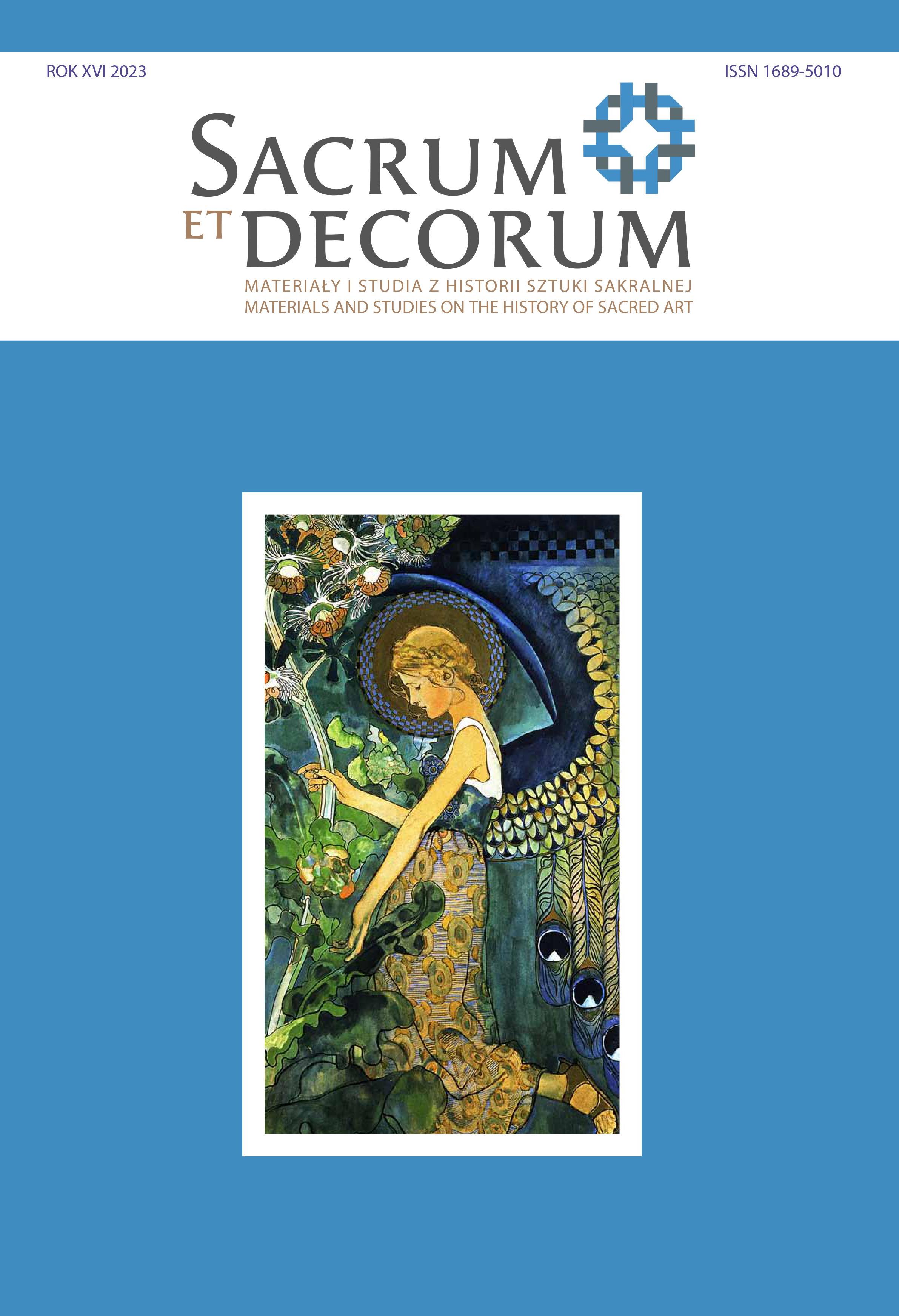Unique fabrics with sacred themes in the Cyprian Kamil Norwid State Secondary School of Fine Arts in Lublin.
Reflections on art for which there is no place in the Church
DOI:
https://doi.org/10.15584/setde.2023.16.6Keywords:
artistic fabric, unique fabric, fabric in the Western Church, Cyprian Kamil Norwid State Secondary School of Fine Arts in LublinAbstract
The starting point for the article are unique fabrics that expose the broadly understood spiritual element in art. All of them were made as diploma works completing the education process on the “artistic textile” specialisation at the Cyprian Kamil Norwid State Secondary School of Fine Arts in Lublin. The aim of the text is not to collect them in the form of a catalogue but, based on eleven selected examples, to indicate the artistic paths followed by young people, discovering various ways of depicting spirituality. Even a cursory review of the research material reveals a multitude of solutions, among which there are two dominant strategies. One draws inspiration from the Christian iconosphere, from specific works, from art produced in specific years and in the style typical for them. The other is looking for an alternative language of artistic expression, sometimes closer to abstraction than to mimetic representations. Both do not shy away from material and technological experiments. Next to fabrics understood as textile products, obtained in the process of weaving with various techniques, there are projects closer to soft sculpture, installations.
The latter part of the article discusses the past significance of decorative fabrics in the interior design of churches and their role in the liturgy of the Western Church. In their context, an attempt is made to indicate the reasons for the contemporary elimination of this artistic field from the sacred interior and for the depreciation of this discipline of art, the status of which is closer to a craft than to the so-called pure arts. In the 1970s, the Church in Poland was one of the patrons of artistic textiles: in the form of purchases and commissions as well as organising large exhibitions presenting the art of fabric. The paper is concluded with reflections on whether a change in this field is possible, because this unique art has a huge ideological potential: it is a carrier of meanings no worse than other art disciplines.
Downloads
References
Duranti Guillelmus, Rationale divinorum officiorum, direct. S. della Torre, M. Marinelli, (Monumenta Studia Instrumenta Liturgica 11), Città del Vaticano 2001.
Dybała I., Paramenty liturgiczne w archidiakonacie lubelskim w XV i XVI wieku. Praca doktorska napisana pod kierunkiem prof. dr hab. J.W. Kuczyńskiej w Katedrze Historii Sztuki Średniowiecznej Polskiej, KUL, Lublin 2016.
Bender A., Kołtryny i tapety – papierowe obicia ścienne w XVI–XIX wieku, „Biuletyn Lubelskiego
Towarzystwa Naukowego. Humanistyka” 30, 1992, nr 1–2 Lublin 1992.
Bender A., Obicia ścienne ze skóry we wnętrzach polskich w XVII wieku, „Biuletyn Lubelskiego Towarzystwa Naukowego” 29, 1987, nr 1, s. 67–73.
Bender A., Szpalery we wnętrzach polskich XVI–XVIII wieku. Terminologia, stan badań i system dekoracji, „Biuletyn Historii Sztuki” 50, 1988, nr 1–2, s. 47–58.
Bender A., Tapiserie z wyprawy ślubnej królowej Bony Sforzy d’Aragona, „Roczniki Humanistyczne” 69, 2021, z. 4, s. 55–69. DOI: https://doi.org/10.18290/rh21694-3
Błaszczyńska J., Polska tkanina artystyczna i użytkowa drugiej połowy XX w. ze szczególnym uwzględnieniem lat 70., „Człowiek i społeczeństwo” 43, 2017, s. 145–163.
Boettner-Łubowski R., Banachowicz A., Królestwo tkaniny i inne terytoria, „Format” 81, 2019, s. 68–72.
Dudeck V., Żytawskie zasłony wielkopostne, wyd. G. Oettel, b.m. 2012.
Huml I., Współczesna tkanina polska, Warszawa 1989.
Kocój E., Borczuch-Białkowska M., Borczuch L., Sacrum na płótnie malowane. Zasłony wielkopostne kościoła św. Jana Chrzciciela w Orawce, Kraków 2021.
Kowalczyk M., Tkanina artystyczna – między tradycją a współczesnością, „Szkoła artystyczna. Seria wydawnicza Centrum Edukacji Artystycznej” 3 (7), 2019, s. 66–117.
Kowalewska M., Przekraczanie granic, w: 16. Międzynarodowe Triennale Tkaniny „Przekraczanie granic”, red. M. Kowalewska, Łódź 2019, s. 12–23.
Michałowska M., Leksykon włókiennictwa. Surowce i barwniki, narzędzia i maszyny, techniki i technologie, wyroby i dziedziny, Warszawa 2006.
Piwocka M., Czyżewski K.J., Nowacki D., Wstęp, w: Wawel 1000–2000. Kultura artystyczna dworu królewskiego i katedry. T. 1 Katedra Krakowska – biskupia, królewska, narodowa, red. M. Piwocka, D. Nowacki, Kraków 2000.
Rak M., Tkanina jako pole działań na styku sztuki i projektowania, „Postępy w inżynierii mechanicznej. Czasopismo naukowo-techniczne” 8 (4), 2016, s. 93–98.
Tyszkiewicz A., Josephinum – klejnot wiedeńskiej muzeologii, „MDWUM. Medycyna, dydaktyka wychowanie. Czasopismo Warszawskiego Uniwersytetu Medycznego” 3, 2019, s. 44–47.
Wasilczyk M., Tkanina artystyczna, w: 85 lat Lubelskiego Plastyka, Lublin 2015, s. 10–12.
Wasilczyk M., Sploty, watki i supły – klisze pamięci z okazji jubileuszu, „Szkoła artystyczna. Seria wydawnicza Centrum Edukacji Artystycznej” 3 (2), 2020, s. 25–49.
Wronikowski B., Alegoryczna interpretacja świątyni w pierwszej księdze „Rationale divinorum officiorum” Wilhelma Duranda, w: Przestrzeń liturgiczna, red. A. Sielepin CHR, J. Superson SAC, Kraków 2019, s. 125–164. DOI: https://doi.org/10.15633/9788374387828.07
Małgorzata Łysiak, Tadeusz Brzozowski https://culture.pl/pl/tworca/tadeusz-brzozowski
Rafał Solewski, Aktualność wiary https://sztukaimetafizyka.up.krakow.pl/rafal-solewski-aktualnosc-wiary/
Downloads
Published
How to Cite
Issue
Section
License
Copyright (c) 2023 Sacrum et Decorum

This work is licensed under a Creative Commons Attribution-NonCommercial-NoDerivatives 4.0 International License.
In line with the Open Access policy, authors retain full copyright to their articles – without restrictions.
Authors can deposit their articles in a repository of their choice.


